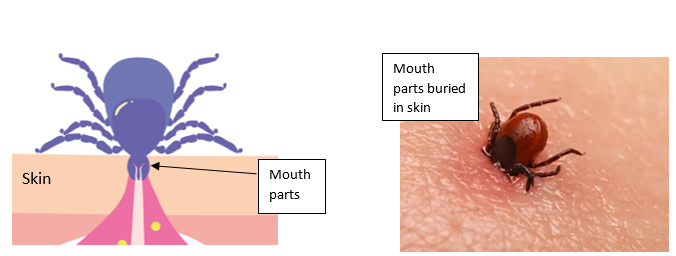Tick bites
How do ticks bite?
Ticks feed by using parts of their mouths to pierce skin so they can drink the blood of the animal. This is the bite. Whilst they feed the parts of the mouth remain under the skin so part of the tick appears buried.
The pictures below show ticks feeding. The diagram on the left shows the mouth parts inside the skin and the picture on the right shows what the tick looks like from the surface.
Ticks release chemicals when they feed. These chemicals include anti-inflammatories (chemicals that suppress the immune response of the host) and analgesics (chemicals that numb the feeding site). This means that people cannot feel the bite so unless people see the tick feeding on them, they may not realise they have been bitten.
As well as these chemicals, ticks can also transfer disease-causing microorganisms such as bacteria or viruses. The risk of the host getting a disease from the microorganisms in a tick bite increases with the time the tick is attached for. This is why it is recommended to remove ticks as soon as possible.
What does a tick bite look like?
When we think of tick bites it’s common to think of/look for the “bulls-eye” shape rash associated with Lyme disease. However, this is not the only presentation so we need to look at the other ways tick bites may present.
Tick bites may cause a red lump to develop at the site of the bite. This is perfectly normal and whilst uncomfortable may not require treatment.
Tick bites can also cause, itching, swelling, blistering and bruising which may be uncomfortable for the patient.
Patients may develop a rash in response to a tick bite. These may not develop at the time of the tick bite and can be signs of serious illness. The images below show examples of rashes from tick bites. These rashes can look similar to an infected insect bite as they may not be the “bull’s eye” shape associated with tick bites.

